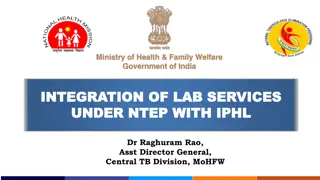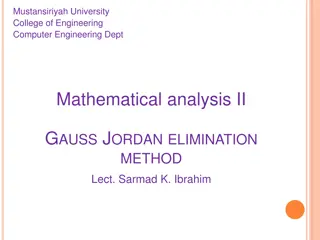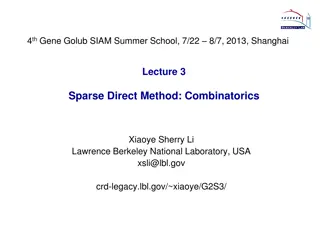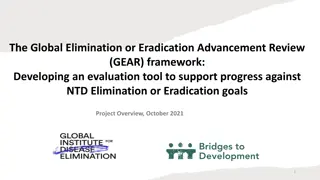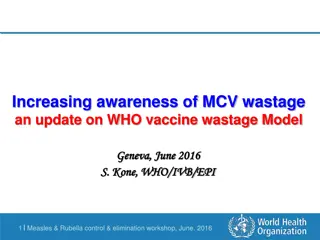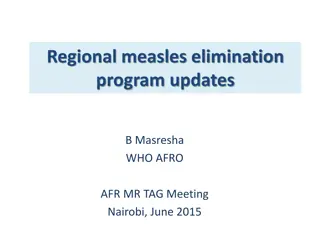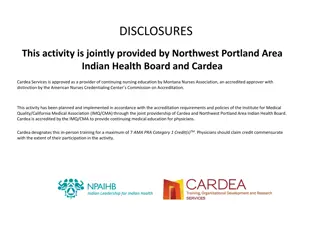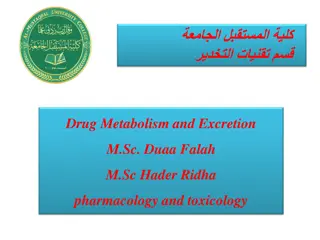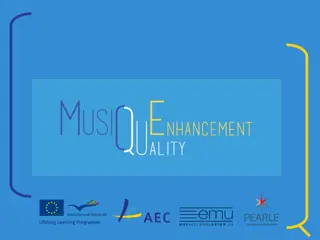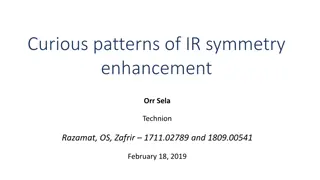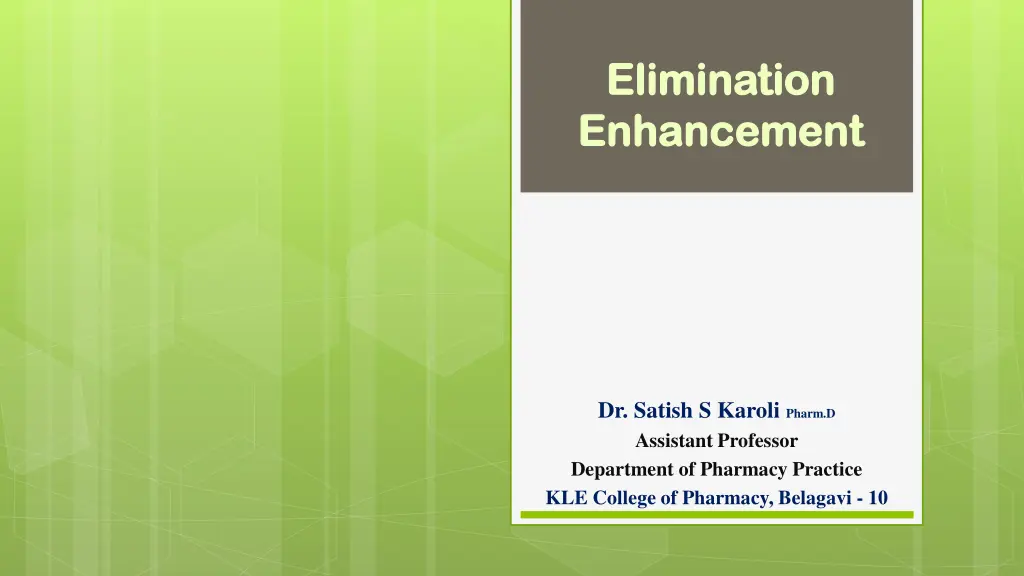
Methods of Eliminating Absorbed Poisons from the Body
Learn about various techniques such as forced diuresis, extracorporeal methods, and more for eliminating absorbed poisons from the body. Understand the principles of forced diuresis and how factors like drug excretion, distribution, and protein binding influence the procedure.
Download Presentation

Please find below an Image/Link to download the presentation.
The content on the website is provided AS IS for your information and personal use only. It may not be sold, licensed, or shared on other websites without obtaining consent from the author. If you encounter any issues during the download, it is possible that the publisher has removed the file from their server.
You are allowed to download the files provided on this website for personal or commercial use, subject to the condition that they are used lawfully. All files are the property of their respective owners.
The content on the website is provided AS IS for your information and personal use only. It may not be sold, licensed, or shared on other websites without obtaining consent from the author.
E N D
Presentation Transcript
Elimination Elimination Enhancement Enhancement Dr. Satish S Karoli Pharm.D Assistant Professor Department of Pharmacy Practice KLE College of Pharmacy, Belagavi - 10
Elimination The various methods of eliminating absorbed poisons from the body include the following: Forced Diuresis Extracorporeal techniques Haemodialysis Plasmapheresis Haemoperfusion Plasma perfusion Peritoneal dialysis Cardiopulmonary bypass. Haemofiltration
Forced Diuresis Most drugs taken in overdose are extensively detoxified by the liver to produce inactive metabolites which are voided in the urine. Sometimes hepatic degradation produces active metabolites, but the secondary compounds are then converted to non-toxic derivatives. Under these circumstances, forced diuresis is inappropriate.
The procedure should be undertaken only if the following conditions are satisfied: A substantial proportion of the drug is excreted unchanged. The drug is distributed mainly in the extracellular fluid. The drug is minimally protein-bound.
Principle: Most drugs are weak electrolytes and exist partly as un dissociated molecules at physiological pH. The extent of ionization is a function of the ionization constant of the drug (Ka for both acids and bases), and the pH of the medium in which it is dissolved. Ionization constants are usually expressed in the form of their negative logarithm, pKa.
Hence the pKa scale is analogous to the pH notation : the stronger an acid the lower its pKa, and the stronger a base the higher its pKa. Thus when pKa = pH, the concentrations of ionised and non-ionised drugs are equal. Cell membranes are most permeable to substances that are lipid soluble and in the non-ionised, rather than the ionised form.
Thus the rate of diffusion from the renal tubular lumen back into the circulation is decreased when a drug is maximally ionised. Because ionisation of acidic drugs is increased in an alkaline environment, and that of basic drugs is increased in an acid solution, manipulation of the urinary pH enhances renal excretion.
Forced alkaline diuresis : This is most useful in the case of phenobarbitone, lithium, and salicylates. Administer 1500 ml of fluid IV, in the first hour as follows : 500 ml of 5% dextrose 500 ml of 1.2 or 1.4% sodium bicarbonate 500 ml of 5% dextrose.
Forced acid diuresis : Forced acid diuresis is no longer recommended for any drug or poison, including amphetamines, strychnine, quinine or phencyclidine.
Extracorporeal techniques: 1. Haemodialysis (Fig 3.6) Haemodialysis was first used in 1913 in experimental poisoning, but was not applied clinically until 1950, when it was used for the treatment of salicylate overdose.
It was widely employed in the subsequent two decades accompanied by much adulatory reportage of its efficacy in medical journals. However, the popularity of haemodialysis has declined since then owing to authentic observation of its lack of utility in several types of poisoning, and the high incidence of complications such as infection, thrombosis, and air embolism.
All drugs are not dialysable, and so it must be ensured before embarking on this procedure that the following conditions are satisfied: The substance should be such that it can diffuse easily through a dialysis membrane. A significant proportion of the substance should be present in plasma water or be capable of rapid equilibration with it.
The pharmacological effect should be directly related to the blood concentration. Table 3.19 outlines the various factors in a toxin which can affect the outcome of haemodialysis. Extensive plasma protein binding, insolubility in water, and high molecular weight are the three most important factors in making haemodialysis ineffective.
Procedure: The three basic components of haemodialysis are the blood delivery system, the dialyser itself, and the composition and method of delivery of the dialysate. For acute haemodialysis, catheters are usually placed in the femoral vein and passed into the inferior venacava. Blood from one is pumped to the dialyser (usually by a roller pump) through lines that contain equipment to measure flow and pressure within the system.
Blood returns through the second catheter. Dialysis begins at a blood flow rate of 50 to 100 ml/min, and is gradually increased to 250 to 300 ml/min, to give maximal clearance. Indications for haemodialysis: Haemodialysis may be considered in those patients not responding to standard therapeutic measures while treating a dialysable toxicant (vide infra).
It may also be considered a part of supportive care whether the toxicant is dialysable or not in the following situations: Stage 3 or 4 coma, or hyperactivity caused by a dialysable agent which cannot be treated by conservative means, marked hyperosmolality which is not due to easily corrected fluid problems, severe acid-base disturbance not responding to therapy, or severe electrolyte disturbance not responding to therapy.
Best indications: Dialysis should be initiated, regardless of clinical condition, in the following situations: after heavy metal chelation in patients with renal failure, and following significant ethylene glycol or methanol ingestion.
Very good indications: Dialysis is usually effective in patients with severe intoxications with the following agents: Lithium Phenobarbitone Salicylates Theophylline.
Fairly good indications: Dialysis may be initiated following exposure to the following agents, if clinical condition deems the procedure necessary (patient deteriorating despite intense supportive care): Alcohols Antibiotics Amphetamines Boric acid Anilines Barbiturates (short acting)
Bromides Chlorates Fluorides Chloral hydrate Quinidine Iodides Quinine Isoniazid Strychnine Meprobamate Thiocyanates. Paraldehyde
Poor indications: Dialysis can be considered as a supportive measure in the presence of renal failure, following exposure to: Paracetamol Antidepressants Antihistamines Belladonna alkaloids Benzodiazepines
Digitalis and related glycosides Glutethimide Opiates Methaqualone Phenothiazines Synthetic anticholinergics.
Complications: Infection (especially AIDS, hepatitis B) Thrombosis Hypotension Air embolism Bleeding (due to use of heparin as a systemic anticoagulant).
2. Haemoperfusion (Fig 3.7): This is a technique that is increasingly becoming popular since it is capable of removing many of the toxins that are not removed well by haemodialysis (Table 3.20).
Procedure: An arteriovenous shunt or a double-lumen venous catheter is inserted into the patient s vascular tree. The haemoperfusion column and lines are primed with heparinized saline in accordance with the manufacturer s instructions and connected to the shunt or catheter. On commencement of perfusion, a bolus of heparin is injected into the arterial line and heparinisation is continued by administering an infusion of heparinized saline.
Complications: Bleeding (because of heparinisation) Air embolism Infection Thrombocytopenia Hypocalcaemia Hypotension.
3. Peritoneal Dialysis: Although widely available, peritoneal dialysis today is almost never recommended for detoxification. In general, it is only 10 to 25% as effective as haemodialysis, and often only slightly more effective than forced diuresis.
It is also time consuming, requiring 24 hours for successful completion as compared to the 2 to 4 hour cycles of haemodialysis and haemoperfusion. The only advantages are that it does not require anticoagulation and uses minimal equipment.
Procedure: Peritoneal dialysis works on the same principle as haemodialysis, allowing the diffusion of toxins from mesenteric capillaries across the peritoneal membrane into the dialysate dwelling in the peritoneal cavity. It involves the placing of a stylet catheter at the bedside under local anaesthesia, or the surgical insertion of a Tenckhoff catheter in the abdomen. Dialysate fluid is instilled, and 1 to 2 litres is exchanged each hour.
Complications: Volume depletion/overload Pain Pneumonia Haemorrhage (from vascular laceration) Pleural effusion Perforation of viscus Hyperglycaemia Bacterial peritonitis Electrolyte imbalance. Arrhythmias
4. Haemofiltration: Haemofiltration is performed similar to haemodialysis except that the blood is pumped through a haemofilter. An arteriovenous pressure difference induces a convective transport of solutes through a hollow fibre flat sheet membrane.
This allows a substantial flow of plasma water, and a high permeability to compounds with molecular weight less than 40,000. The procedure can be done intermittently at high ultrafiltrate rates of upto 6 litres/hour, or continuously at rates of 100 ml/hour (Continuous Arteriovenous Haemofiltration, or CAVH). The latter is preferred in the treatment of poisoning.
The main advantage of Haemofiltration is that it can remove compounds of large relative molecular weight (4,500 40,000). Such compounds include aminoglycoside antibiotics and metal chelates (such as iron-desferrioxamine). CAVH is also useful in poisoning with lithium, methanol, ethanol, and ethylene glycol
5. Haemodiafiltration: This is a combination of haemofiltration with haemodialysis. It has been undertaken very rarely, and nothing much is known as to its actual advantages, if any.
6. Plasmapheresis: Plasmapheresis is a technique of separating cellular blood components from plasma. The cells are resuspended in either colloids, albumin, or fresh frozen plasma, and then reinfused.
It is very effective in eliminating toxic substances but exacts a heavy toll: a part of the patient s plasma proteins are sacrificed in the process. Plasmapheresis has been used in cases of overdose with theophylline, carbamazepine, amanita, mercury, hemlock, etc., but serious complications greatly limit its utility.
Complications: Bleeding disorders: DIC, thrombocytopenia Hypercoagulation: Cerebral thrombosis, pulmonary embolism, myocardial infarction. Anaphylaxis. Fluid overload: Hypertension, congestive heart failure. Infection.
Vessel perforation, air embolism. Dysequilibrium syndrome: Vomiting, hypovolaemia. Citrate toxicity: Paraesthesias, tetany, chills, arrhythmias. Convulsions. Metabolic alkalosis.
7. Plasma Perfusion : This is a combination of plasmapheresis and haemoperfusion, and has rarely been used in poisoning. 8. Cardiopulmonary Bypass: This is another rarely used experimental procedure in the treatment of poisoning, and has been shown to be useful in certain cases of overdose involving cardiac depressants such as verapamil and lidocaine.



